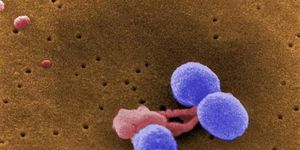Researchers Identify New Cellular Signaling Mechanisms
Molecules and drugs move among cells and bind to receptors on the cell surface, which can initiate a cascade of reactions that are involved in many different aspects of physiology. The biggest and most diverse group of receptors is called G-protein-coupled receptors (GPCRs). Around a third of approved medicines act on GPCRs, and we don’t know about what a third of GPCRs bind to in order to activate other signals and functions.
New research reported in Cell by an international team has revealed new signaling mechanisms that are used by five GPCRs, which are activated by 17 different peptides. The known network of GPCRs and their receptors, or ligands, has now been expanded from 348 to 415, which represents about 19 percent of all of them.
"Researchers can spend their whole career studying one GPCR signaling system because their therapeutic potential is vast, as shown by the sheer number of medical drugs targeting them. In this study, we have identified five new such systems. In other words, this doesn't happen every day and it might have huge implications for drug development," said the lead study author David E. Gloriam, a Professor at the Department of Drug Design and Pharmacology at the University of Copenhagen.
The scientists knew that peptides, short chains of amino acids, make up about 71 percent of the ligands that bind GPCRs. In this study, the investigators isolated the proteins in the cell, the proteome, and identified the potential peptide ligands after focusing on peptides that the cell releases. All peptides with a known function were eliminated. They then began to predict which of them might bind to GPCRs.
"In combining computational drug design with pharmacology, machine learning and genomics we have used a truly collaborative method in order to identify these new aspects of human biology. We would not have been able to identify this many pairs had it not been for the interdisciplinary nature of our method," noted David E. Gloriam.
The team narrowed down the peptides to a list of 218 and tested them against 21 receptors. They used three different screening methods. After three years, the investigators found five GPCRs that were matched to 27 ligands. The genes that encode for the peptide ligands were also identified, and have also been shown in previous work to be linked to a variety of different diseases.
The researchers are hopeful that the molecular signals they’ve identified have potential in the search for therapeutics. They are continuing to learn more about the signaling mechanisms and how they relate to biological functions.
Sources: AAAS/Eurekalert! via University of Copenhagen, Cell









